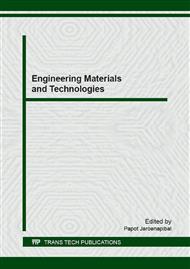[1]
M. Ayoub, AZ. Abdullah, Critical review on the current scenario and significance of crude glycerol resulting from biodiesel industry towards more sustainable renewable energy industry, Renewable and Sustainable Energy Reviews, 16 (2012) 2671-2686.
DOI: 10.1016/j.rser.2012.01.054
Google Scholar
[2]
E. Astuti, Supranto, Rochmadi, A. Prasetya, Determination of the temperature effect on glycerol nitration processes using the HYSYS predictions and the laboratory experiment, Indo. J Chem. 14 (2014) 57-62.
DOI: 10.22146/ijc.21268
Google Scholar
[3]
E. Astuti, Supranto, Rochmadi, A. Prasetya, Kinetic modeling of nitration of glycerol: three controlling reactions model, Engineering Journal. 18 (2014) 73-82.
DOI: 10.4186/ej.2014.18.3.73
Google Scholar
[4]
E. Astuti, Supranto, Rochmadi, A. Prasetya, A thermodynamic study of parameters that affect the nitration of glycerol with nitric acid, International journal of chemical, molecular, nuclear, materials and metallurgical engineering, 9 (2015).
Google Scholar
[5]
E. Astuti, Supranto, Rochmadi, A. Prasetya, Optimum Operating Conditions Of Glycerol Nitration to Produce 1, 3-Dinitroglycerin Kinetic modeling of nitration of glycerol, ARPN Journal of Engineering and Applied Sciences, 11 (2016) 5203-5209.
DOI: 10.5539/mas.v8n2p78
Google Scholar
[6]
RL. Willer, RS. Day, AG. Stern, Isotactic poly(glycidyl nitrate) and synthesis thereof. US Patent 5, 162, 494. (1992).
Google Scholar
[7]
RW. Millar, NC. Paul, P. Golding, Preparation of epoxy nitrat, US Patent 5, 136, 062. (1992).
Google Scholar
[8]
NC. Paul, RW. Millar, P. Golding, Preparation of nitroalkyl- substituted cyclic esters, US Patent 5, 145, 974. (1992).
Google Scholar
[9]
HJ. Desai, AV. Cunliffe, T. Lewis, RW. Millar, NC. Paul, MJ. Stewart, AJ. Amass, Synthesis of narrow molecular weight á, ù-hydroxy telechelic poly(glycidyl nitrate) and estimation of theoretical heat of explosion, Polymer, 37 (1996) 3471-3476.
DOI: 10.1016/0032-3861(96)88499-0
Google Scholar
[10]
Y.G. Cheun, JR. Cho, YJ. Kim, JR. Park, An improved synthetic method of energetic poly(glycidyl nitrate) prepolimer, Polymer (Korea), 21 (1997) 7-15.
Google Scholar
[11]
TK. Highsmith, AJ. Sanderson, LF. Cannizzo, RM. Hajik, Polymerization of poly(glycidyl nitrate) from high purity glycidyl nitrate synthesized from glycerol, US Patent 6, 362, 311. (2002).
Google Scholar
[12]
DL. Kaplan, JH. Cornell, AM. Kaplan, Biodegradation of glycidol and glycidol nitrate, Appl. Environ. Microbiol. 44 (1982) 144-150.
DOI: 10.1128/aem.43.1.144-150.1982
Google Scholar
[13]
TK. Highsmith, HE. Johnston, Continuous process and system for production of glycidyl nitrate from glycerin, nitric acid and caustic and conversion of glycidyl nitrate to poly(glycidyl nitrate), US Patent 6, 870, 061. (2005).
Google Scholar


